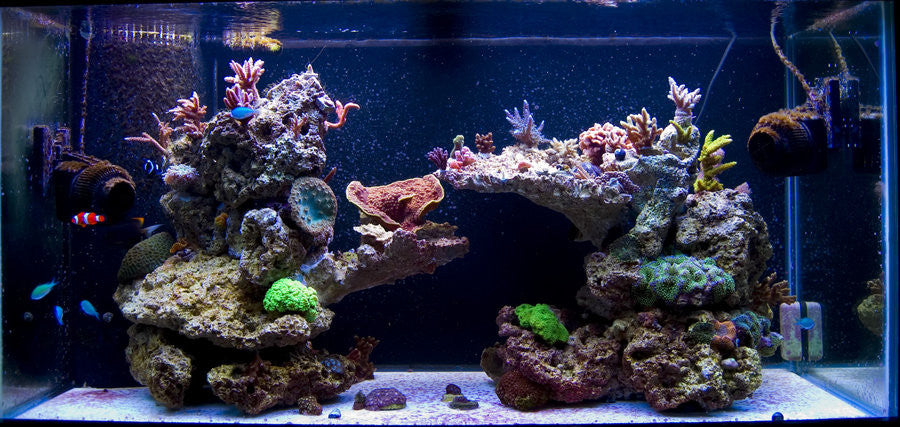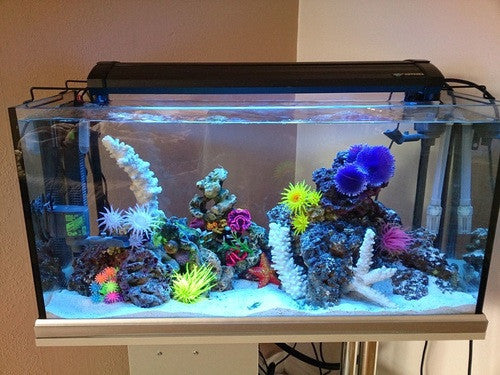The Easiest Way to Setup a Saltwater Aquarium: Part 2
Establishing Live Rocks in an Aquarium
Aquariums are beautiful particularly ones which are large enough to make the viewer feel as though they have been transported into an underwater wonderland. For many individuals, the inside of a clear glass aquarium is as close as they will ever come to the wonders of the world beneath the ocean's surface, and for that reason an aquarium which is as close to the natural habitat of its inhabitants as possible is a joy unto itself.
Live rocks, rocks which are covered with both micro- and microorganisms which help to digest the waste produced by the fish, are a vital part of every natural ecosystem. For that reason, it makes sense that they would be an important part of an aquarium environment as well. It is not as simple as dropping a rock into an aquarium and allowing all manner of things to grow on it, however. There is a process that must be followed to ensure optimal benefits for both the large aquarium and the live rock.
It is very simple to cure live rock before placing it in the aquarium, but this is an important step that must be taken to prevent a buildup of ammonia in the tank which could negatively affect the fish. To cure live rock first select a plastic container that is of a suitable size to hold the amount of live rock which you are working with, then fill it with saltwater. Then place a heater and water pump in the "tank" for optimal temperature and circulation. Once the water has reached the desired temperature remove the heater and pump and half of the water content, then preclean the rock in a bucket of saltwater by swishing it around to remove any lose organisms and debris and place it in the prepared water. Then reinstall the heater and pump and allow nature to do its thing!
Setting Up Rocks in Saltwater Aquariums
The process is done when an ammonia reading of the water in which the rock resides is at zero and it is no longer giving off an unpleasant odor. Now, it is safe to place the rock in your aquarium and allow Mother Nature's perfect filtering system to work for you.



 Ocean water is the natural habitat of all saltwater marine animals and, consequently, the best water source for any saltwater aquarium. If ocean water is not available, however, and the owner of a saltwater aquarium does not wish to purchase a pre-made saltwater solution it is possible to make saltwater. It is important to use a sea salt mixture that is free of impurities rather than table salt when creating saltwater to reproduce the natural environment as accurately as possible. These mixes can be purchased from any store that specializes in the sale of tropical fish.
Ocean water is the natural habitat of all saltwater marine animals and, consequently, the best water source for any saltwater aquarium. If ocean water is not available, however, and the owner of a saltwater aquarium does not wish to purchase a pre-made saltwater solution it is possible to make saltwater. It is important to use a sea salt mixture that is free of impurities rather than table salt when creating saltwater to reproduce the natural environment as accurately as possible. These mixes can be purchased from any store that specializes in the sale of tropical fish. 
 It is important for you to learn all you can BEFORE you begin obtaining the things you need for Koi keeping. This way, you will not slip up and should replace anything that you have already done or bought. Planning will not only save your money, but it will potentially save your sanity as well.
It is important for you to learn all you can BEFORE you begin obtaining the things you need for Koi keeping. This way, you will not slip up and should replace anything that you have already done or bought. Planning will not only save your money, but it will potentially save your sanity as well.
 You may notice that the water in your pond is extremely clear when the seasons are changing from Winter to Spring. Do not let this fool you, as there are several factors that will cause problems once Summer comes if you do not remedy these issues ahead of time.
You may notice that the water in your pond is extremely clear when the seasons are changing from Winter to Spring. Do not let this fool you, as there are several factors that will cause problems once Summer comes if you do not remedy these issues ahead of time.
 It is important to set up and run an aquarium before any fish are introduced into the environment. Wash the tank and any substrate and decorations thoroughly with water. Don't use any soap. Fill the tank with de-chlorinated water and attach filters and lighting. Allow the tank to cycle until the water is no longer cloudy and sufficient P.H and water temperatures have been established.
It is important to set up and run an aquarium before any fish are introduced into the environment. Wash the tank and any substrate and decorations thoroughly with water. Don't use any soap. Fill the tank with de-chlorinated water and attach filters and lighting. Allow the tank to cycle until the water is no longer cloudy and sufficient P.H and water temperatures have been established. 

